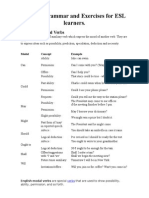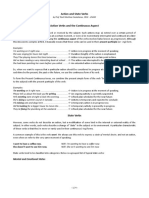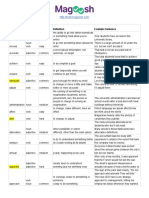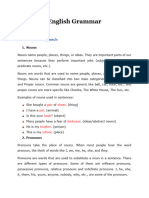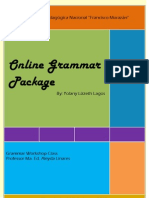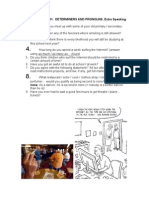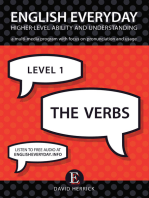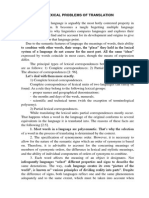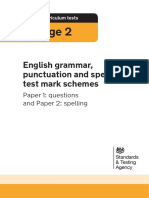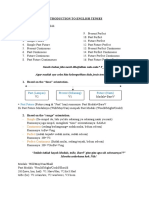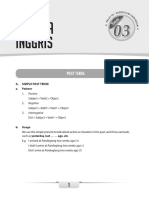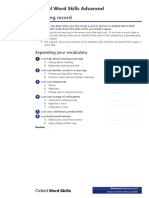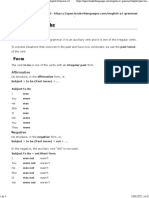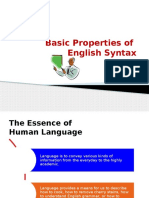Ammar Step by Step2
Ammar Step by Step2
Uploaded by
mjimenezmj5183Copyright:
Available Formats
Ammar Step by Step2
Ammar Step by Step2
Uploaded by
mjimenezmj5183Original Title
Copyright
Available Formats
Share this document
Did you find this document useful?
Is this content inappropriate?
Copyright:
Available Formats
Ammar Step by Step2
Ammar Step by Step2
Uploaded by
mjimenezmj5183Copyright:
Available Formats
Tenaya Press
Palo Alto, CA
English Grammar:
Step by Step
Written by Elizabeth Weal
Illustrated by Anastasia Ionkin
2
English Grammar: Step by Step 2 iii
Contents
Welcome . . . . . . . . . . . . . . . . . . . . . . . . . . . . . . . . . . . . . . . . . . . . . . . . . . . . . . . . . . . . . . . . . . . . . . . . v
Chapter 1: My shoes are under the chair. . . . . . . . . . . . . . . . . . . . . . . . . . . . . . . . . . . . . . . 1
1.1 Introducing Prepositions . . . . . . . . . . . . . . . . . . . . . . . . . . . . . . . . . . . . . . . . . . . . . . . . . . . . . . 2
1.2 Household Vocabulary . . . . . . . . . . . . . . . . . . . . . . . . . . . . . . . . . . . . . . . . . . . . . . . . . . . . . . . . 4
1.3 More Prepositions of Location. . . . . . . . . . . . . . . . . . . . . . . . . . . . . . . . . . . . . . . . . . . . . . . . . 6
1.4 Where Questions with Objects . . . . . . . . . . . . . . . . . . . . . . . . . . . . . . . . . . . . . . . . . . . . . . . . . 8
1.5 Where Questions with People . . . . . . . . . . . . . . . . . . . . . . . . . . . . . . . . . . . . . . . . . . . . . . . . . 10
Chapter 1 Summary . . . . . . . . . . . . . . . . . . . . . . . . . . . . . . . . . . . . . . . . . . . . . . . . . . . . . . . 12
More Practice! . . . . . . . . . . . . . . . . . . . . . . . . . . . . . . . . . . . . . . . . . . . . . . . . . . . . . . . . . . . . 13
Chapter 2: What is Joses date of birth? . . . . . . . . . . . . . . . . . . . . . . . . . . . . . . . . . . . . . . . . . . . 17
2.1 What time Questions . . . . . . . . . . . . . . . . . . . . . . . . . . . . . . . . . . . . . . . . . . . . . . . . . . . . . . . . . 18
2.2 Days, Months and Dates . . . . . . . . . . . . . . . . . . . . . . . . . . . . . . . . . . . . . . . . . . . . . . . . . . . . . 20
2.3 When Questions . . . . . . . . . . . . . . . . . . . . . . . . . . . . . . . . . . . . . . . . . . . . . . . . . . . . . . . . . . . . . 22
2.4 What Questions. . . . . . . . . . . . . . . . . . . . . . . . . . . . . . . . . . . . . . . . . . . . . . . . . . . . . . . . . . . . . . 24
2.5 Possessive Nouns . . . . . . . . . . . . . . . . . . . . . . . . . . . . . . . . . . . . . . . . . . . . . . . . . . . . . . . . . . . . . 26
2.6 Question Word Questions vs. Yes/No Questions. . . . . . . . . . . . . . . . . . . . . . . . . . . . . . . 28
Chapter 2 Summary . . . . . . . . . . . . . . . . . . . . . . . . . . . . . . . . . . . . . . . . . . . . . . . . . . . . . . . 30
More Practice! . . . . . . . . . . . . . . . . . . . . . . . . . . . . . . . . . . . . . . . . . . . . . . . . . . . . . . . . . . . . 31
Chapter 3: Teres a pizza in the oven. . . . . . . . . . . . . . . . . . . . . . . . . . . . . . . . . . . . . . . . . . . . . 35
3.1 Introducing There is and There are. . . . . . . . . . . . . . . . . . . . . . . . . . . . . . . . . . . . . . . . . . 36
3.2 There + Is = Theres . . . . . . . . . . . . . . . . . . . . . . . . . . . . . . . . . . . . . . . . . . . . . . . . . . . . . . . . . 38
3.3 Negative Statements: There isnt and There arent . . . . . . . . . . . . . . . . . . . . . . . . . . . 40
3.4 Questions with Is there and Are there . . . . . . . . . . . . . . . . . . . . . . . . . . . . . . . . . . . . . . . 42
3.5 Answering Is there and Are there Questions . . . . . . . . . . . . . . . . . . . . . . . . . . . . . . . . 44
3.6 More about Yes/No Questions . . . . . . . . . . . . . . . . . . . . . . . . . . . . . . . . . . . . . . . . . . . . . . . . 46
Chapter 3 Summary . . . . . . . . . . . . . . . . . . . . . . . . . . . . . . . . . . . . . . . . . . . . . . . . . . . . . . . . . . 48
More Practice! . . . . . . . . . . . . . . . . . . . . . . . . . . . . . . . . . . . . . . . . . . . . . . . . . . . . . . . . . . . . 49
Chapter 4: I play soccer once a week. . . . . . . . . . . . . . . . . . . . . . . . . . . . . . . . . . . . . . . . . . . . . . . 53
4.1 Identifying Verbs . . . . . . . . . . . . . . . . . . . . . . . . . . . . . . . . . . . . . . . . . . . . . . . . . . . . . . . . . . . . . .54
4.2 Introducing Simple Present Tense Verbs. . . . . . . . . . . . . . . . . . . . . . . . . . . . . . . . . . . . . . .56
4.3 More about Simple Present Tense Verbs . . . . . . . . . . . . . . . . . . . . . . . . . . . . . . . . . . . . . . .58
4.4 Using Simple Present Tense Verbs Correctly. . . . . . . . . . . . . . . . . . . . . . . . . . . . . . . . . . .60
4.5 Rules for Spelling Simple Present Tense Verbs . . . . . . . . . . . . . . . . . . . . . . . . . . . . . . . . .62
4.6 Irregular Present Tense Verbs: Goes, Does and Has . . . . . . . . . . . . . . . . . . . . . . . . . . 64
4.7 When to Use Simple Present Tense Verbs . . . . . . . . . . . . . . . . . . . . . . . . . . . . . . . . . . . . . .66
4.8 Adverbs of Frequency: Always, Usually, Sometimes, Never . . . . . . . . . . . . . . . . . .68
4.9 Once a Week, Once a Month, Once a Year . . . . . . . . . . . . . . . . . . . . . . . . . . . . . . . . . . . . .70
Chapter 4 Summary . . . . . . . . . . . . . . . . . . . . . . . . . . . . . . . . . . . . . . . . . . . . . . . . . . . . . . . 72
More Practice! . . . . . . . . . . . . . . . . . . . . . . . . . . . . . . . . . . . . . . . . . . . . . . . . . . . . . . . . . . . . .73
iv English Grammar: Step by Step 2
Chapter 5: I dont have a car. . . . . . . . . . . . . . . . . . . . . . . . . . . . . . . . . . . . . . . . . . . . . . . . . . . 77
5.1 Negative Statements with Present Tense Verbs . . . . . . . . . . . . . . . . . . . . . . . . . . . . . 78
5.2 More Negative Statements with Present Tense Verbs. . . . . . . . . . . . . . . . . . . . . . . 80
5.3 Negative Statements with Has, Goes and Does . . . . . . . . . . . . . . . . . . . . . . . . . . . . 82
5.4 Using Dont and Doesnt. . . . . . . . . . . . . . . . . . . . . . . . . . . . . . . . . . . . . . . . . . . . . . . . . . 84
5.5 Doesnt vs. Isnt. . . . . . . . . . . . . . . . . . . . . . . . . . . . . . . . . . . . . . . . . . . . . . . . . . . . . . . . . . . 86
5.6 Asking Yes/No Questions with Do and Does . . . . . . . . . . . . . . . . . . . . . . . . . . . . . . 88
5.7 Answering Yes/No Questions with Do and Does. . . . . . . . . . . . . . . . . . . . . . . . . . . 90
5.8 Yes, I do vs. Yes, I am . . . . . . . . . . . . . . . . . . . . . . . . . . . . . . . . . . . . . . . . . . . . . . . . . . . . . 92
5.9 Where, When, and What Time Quesstions . . . . . . . . . . . . . . . . . . . . . . . . . . . . . . . . . 94
Chapter 5 Summary . . . . . . . . . . . . . . . . . . . . . . . . . . . . . . . . . . . . . . . . . . . . . . . . . . . . 96
More Practice! . . . . . . . . . . . . . . . . . . . . . . . . . . . . . . . . . . . . . . . . . . . . . . . . . . . . . . . . . 97
Chapter 6: Im studying English now. . . . . . . . . . . . . . . . . . . . . . . . . . . . . . . . . . . . . . . . . 101
6.1 Introducing Present Progressive Tense Verbs . . . . . . . . . . . . . . . . . . . . . . . . . . . . . 102
6.2 Spelling Present Progressive Verbs. . . . . . . . . . . . . . . . . . . . . . . . . . . . . . . . . . . . . . . . 104
6.3 Negative Sentences . . . . . . . . . . . . . . . . . . . . . . . . . . . . . . . . . . . . . . . . . . . . . . . . . . . . . . . 106
6.4 Contractions . . . . . . . . . . . . . . . . . . . . . . . . . . . . . . . . . . . . . . . . . . . . . . . . . . . . . . . . . . . . . 108
6.5 Yes/No Questions and Answers . . . . . . . . . . . . . . . . . . . . . . . . . . . . . . . . . . . . . . . . . . . 110
6.6 Question Word Questions and Answers. . . . . . . . . . . . . . . . . . . . . . . . . . . . . . . . . . . 112
6.7 Present Progressive Verbs vs. Simple Present Verbs . . . . . . . . . . . . . . . . . . . . . . . 114
Chapter 6 Summary . . . . . . . . . . . . . . . . . . . . . . . . . . . . . . . . . . . . . . . . . . . . . . . . . . . 116
More Practice! . . . . . . . . . . . . . . . . . . . . . . . . . . . . . . . . . . . . . . . . . . . . . . . . . . . . . . . . 117
Appendix A: Answers . . . . . . . . . . . . . . . . . . . . . . . . . . . . . . . . . . . . . . . . . . . . . . . . . 121
Appendix B: Contractions with to be. . . . . . . . . . . . . . . . . . . . . . . . . . . . . . . . . . 131
Glossary of Grammar Terms . . . . . . . . . . . . . . . . . . . . . . . . . . . . . . . . . . . . . . . . . . . 132
Index . . . . . . . . . . . . . . . . . . . . . . . . . . . . . . . . . . . . . . . . . . . . . . . . . . . . . . . . . . . . . . . . . . 133
English/Spanish Dictionary. . . . . . . . . . . . . . . . . . . . . . . . . . . . . . . . . . . . . . . . . . . . 134
Spanish/English Dictionary. . . . . . . . . . . . . . . . . . . . . . . . . . . . . . . . . . . . . . . . . . . . 139
English Grammar: Step by Step 2 v
Welcome
A note to students
Welcome to English Grammar: Step by Step 2, a book that will help you understand the
basics of English grammar so that you can speak and write English correctly.
Te assumption behind this book is that anyone can learn English grammar, regardless
of their level of education. To ensure that this occurs, grammar concepts are presented
in a step-by-step fashion, starting at the most basic level. Each new concept is followed
by exercises that give you the opportunity to practice what youve learned and additional
exercises at the end of each chapter provide even more practice. All of the answers to the
exercises are in an appendix, so you can check your work as you go. A dictionary of all
the words used in this book is included in the back of the book, making it easy to look
up words you dont know how to spell. Te dictionary also includes pronunciation.
Tis book assumes that you have a very basic knowledge of English grammar.
Specifcally, you should know how to use the verbs to be (am, is and are) and to have;
and how to use possessive adjectives (his, her, our, etc.). You also should know how
to identify nouns, pronouns and adjectives and use basic punctuation (periods and
question marks) correctly. If these topics are unfamiliar to you, work through English
Grammar: Step by Step 1; then continue with this book.
Keep in mind that the focus of this book is exclusively on grammar. Learning English
requires many other skills in addition to grammar, such as pronunciation, listening
comprehension, vocabulary development, and so on. At the same time, if you want to
advance in English youll need a solid foundation in basic grammar, which is precisely
what this book provides.
A note to teachers
English Grammar: Step by Step 2 was written to help Spanish-speaking students learn
grammar in a simple, straightforward manner. It focuses on many of the grammar
points that are most confusing to new English language learners: prepositions, simple
present tense verbs and present progressive verbs. It assumes that students know how
to use the verbs to be and to have and understand the use of possessive adjectives (his,
her, our, etc.). Students also should be able to identify nouns, pronouns and adjectives.
and use basic punctuation (periods and question marks) correctly. If students are not
familiar with these topics, they should work through English Grammar: Step by Step 1;
then continue with this book.
Teachers can use this book as a classroom text in classes with only Spanish-speakers or
as a supplement for Spanish-speaking students in mixed-language classes. Tese books
can also be made available to students in distance learning programs and in school
bookstores that stock ESL materials. Many teachers also sell these books to students so
they can use it at home.
vi English Grammar: Step by Step 2
Because the book is available in English and Spanish, teachers who dont speak Spanish can read the English
version to learn some basic diferences between English and Spanish grammar, then make the Spanish
version of the book available to their students.
Acknowledgements
Many people gave me the encouragement I needed to embark on the second book in this series. My friend
and colleague Maria Kleczewska was the inspiration for the frst book and ofered invaluable encouragement
the second time around. Lorraine Reston provided valuable editorial input. Gabriela Urricariet was a
skilled and thorough editor and translator. Her eye for detail helped make this book a success. Anastasia
Ionkin, an incredibly talented artist, created the drawings that make this book fun to read. Stuart Silberman
transformed my original manuscript from a sea of gray into a document thats both easy to use and inviting
to read. Beth Zonderman designed the book cover. Julie Reis and Phyllis Mayberg were excellent copy editors.
My friend Mary Bender opened my eyes to the beauty of Latin American textiles in general and to molas in
particular. A mola from her collection is pictured on the cover of this book.
I also want to thank the many Sequoia Adult School staf membersincluding Barbara Hooper, Lionel
De Maine, Pat Cocconi, Ana Escobar, Soledad Rios, Maria Ibarra, and Juan Ramirezwho have supported
my eforts and helped make my books available to Sequoia Adult School students.
My extraordinary husband Bruce Hodge unfaggingly supported my eforts and helped with countless tasks,
from design assistance to 24/7 technical support. Without his help, this book would not exist. My daughters
Chelsea and Caroline provided editorial and artistic input. Finally, I want to thank the many students who
completed my frst book; then thanked me for making English grammar understandable. Tey continue to
be my inspiration.
English Grammar: Step by Step 2 1
My shoes are under
the chair.
Chapter 1
I
magine this situation: Youre late for work. Your boss, who
speaks only English, calls you on your cell phone to fnd
out where you are. If you cant answer him, youre going to
have a problem! In this chapter, youll learn how to answer
questions about where you are and also about where things
are at home and on the job.
At the end of this chapter you will be able to
identify prepositions.
use prepositions to describe where people and objects are
located.
ask and answer questions about where people and objects
are located.
2 English Grammar: Step by Step 2
1.1
A preposition is a word that shows the relationship between words in a sentence.
En, a, entre and sin are all Spanish prepositions. A preposition of location or a
preposition of place describes where something or someone is located, In this
section, youll learn several prepositions of location. In the following illustrations,
each preposition of place is underlined.
Note that in and on have diferent meanings. In general, in means dentro de and
on means sobre.
A preposition is a part of speech
To understand English or Spanish grammar, it is very useful to understand parts
of speech, names that you use to specify how a word is used in a sentence. Here is a
summary of the parts of speech you should be familiar with.*
Part of speech Defnition Examples
noun (sustantivo) A person, place, animal or
thing
teacher (maestra); school
(escuela); dog (perro); table
(mesa)
pronoun (pronombre) A word that takes the place of
a noun
I (yo); you (usted, t,
ustedes); we (nosotros,
nosotras); he (l); she (ella)
adjective (adjetivo) A word that modifes or
describes a noun or pronoun
big (grande, grandes);
beautiful (bonito, bonita,
bonitos, bonitas)
verb (verbo) A word that shows action or
state of being
is (ser, estar); have (tener);
work (trabajar)
preposition
(preposicin)
A word that shows the
relationship between other
words in a sentence.
under (abajo de); above
(arriba de)
*If you are unclear how to identify nouns, pronouns, and adjectives, read Gramtica del ingls: Paso a paso 1.
Well talk more about how to identify verbs in Chapter 4.)
Introducing Prepositions
Y
o
u
r
t
u
r
n
!
English Grammar: Step by Step 2 3
1.1.a Directions: One of the three words in each group of words is not a preposition. Cross out the word
that is not a preposition. (If you dont know a word, look it up in the dictionary in the back of this book.)
1. boy, above, in 3. television, under, above
2. in, husband, on 4. on, above, tired
1.1.b Directions: One of the three words in each group of words is not a noun. Cross out the word that is
not a noun. Remeber that a noun is a person, place, animal or thing.
1. microwave, beautiful, house 5. cousin, aunt, at
2. apartment, table, in 6. cat, dog, dirty
3. eggs, book, happy 7. above, cofee, car
4. black, dress, house 8. year, month, are
1.1.c Directions: One of the three words in each group of words is not a pronoun. Cross out the word that
is not a pronoun. Remember that a pronoun is a word that can replace a noun.
1. he, doctor, she 5. they, we, pencil
2. white, she, it 6. backpack, it, you
3. I, store, you 7. she, sad, we
4. ball, it, they 8. happy, he, they
1.1.d Directions: One of the three words in each group of words is not an adjective. Cross out the word
that is not an adjective. Remember that an adjective is a word that describes a noun or pronoun.
1. cashier, tired, handsome 5. beautiful, apple, red
2. blue, airplane, purple 6. old, new, dog
3. yellow, happy, it 7. above, heavy, thin
4. sad, lazy, person 8. interesting, good, student
1.1.e Directions: Write the preposition that describes each drawing.
1. The rabbit is ___________ the box. 3. The rabbit is ___________ the box.
2. The rabbit is ___________ the box. 4. The rabbit is ___________ the box.
on
4 English Grammar: Step by Step 2
Youll ofen use prepositions of location to tell where things are located around
your house. Te following illustrations show the rooms in a house and whats ofen
found in each one. Te dictionary in the back of this book tells you how these
words are pronounced. Youll use these words in the exercises on the next page.
1.2
Household Vocabulary
You use the preposition in to refer to objects in a room. For example:
The apples are in the kitchen. (Las manzanas estn en la cocina.)
The toys are in the living room. (Los juguetes estn en la sala.)
Y
o
u
r
t
u
r
n
!
English Grammar: Step by Step 2 5
1.2.a Directions: Identify the items in each picture.
Kitchen Bedroom
1. ________________________ 1. ________________________
2. ________________________ 2. ________________________
3. ________________________ 3. ________________________
4. ________________________ 4. ________________________
5. ________________________ Bathroom
6. ________________________ 1. ________________________
Living room 2. ________________________
1. ________________________ 3. ________________________
2. ________________________ 4. ________________________
3. ________________________ 5. ________________________
4. ________________________
5. ________________________
6. ________________________
microwave
6 English Grammar: Step by Step 2
Here are a few more prepositions of location to study.
Te preposition between
In both English and Spanish, the preposition between (entre) is always followed by
two singular nouns or by one plural noun. For example, if a cat is between two boxes,
you say
The cat is between the boxes. (El gato est entre las cajas.)
If the cat is between a box and a ball, you say
The cat is between the box and the ball. (El gato est entre la caja y la pelota.)
It is incorrect to say
The cat is between the box. (El gato est entre la caja.)
Prepositions composed of more than one word
You may have noticed that several prepositions in both English and Spanish are
more than one word long. Tese are sometimes called compound prepositions.
For example, next to is two words; al lado de is three words. Regardless of the
language, whats important is to include every word of the compound preposition
and to make sure you properly separate the words that comprise the compound
preposition. Tus, you say
The cat is next to the box. (El gato est al lado de la caja.)
It is incorrect to say
The cat is next the box. / The cat is nexto the box.
1.3
More prepositions of location
Y
o
u
r
t
u
r
n
!
English Grammar: Step by Step 2 7
1.3.a Directions: Write the preposition that describes each drawing.
1. The rabbit is ________________ the box. 3. The rabbit is _________________ the box.
2. The rabbit is ________________ the boxes. 4. The rabbit is ___________ the box.
1.3.b Directions: One of the sentences in each pair is not a correct sentence. Cross out the incorrect
sentence.
1a. The table is in front of the sofa. 1b. The table is in the sofa.
2a. The couch is between the end tables. 2b. The couch is between the end table.
3a. I am in the bedroom. 3b. I am on the bedroom.
4a. The blender is in the counter. 4b. The blender is on the counter.
5a. She is next to her sister. 5b. She is next her sister.
6a. I am in front my apartment. 6b. I am in front of my apartment.
7a. The pencil is on the foor. 7b. The pencil is in the foor.
8a. The store is between the school. 8b. The store is between the school and the
park.
9a. Your shoes are next the window. 9b. Your shoes are next to the window.
10a. The oranges are in the kitchen. 10b. The oranges are on the kitchen.
1.3.c Directions: Translate these sentences.
1. Los libros estn al lado de la lmpara.
2. El cuadro est arriba del sof.
3. Mi casa est al lado de la tienda.
4. Mi ta est en la cocina.
5. Tu libro est entre el cuaderno y el
bolgrafo.
6. Las sillas estn delante de la mesa.
7. Nuestro carro est delante de la casa.
Te books are next to the lamp.
behind
8 English Grammar: Step by Step 2
Now that you know some prepositions, youre ready to start asking questions about
where things are. Study this conversation.
Note the following:
Te mother uses Where is in the frst question because she is asking her daughter
about her backpack, which is singular.
Te mother uses Where are in the second question because she is asking her daughter
about her shoes, which are plural.
Note that the response to the frst question is
It is on the foor. (Est en el piso.)
It is less common, but also correct, to reply
My backpack is on the foor. (Mi mochila est en el piso.)
Questions made with where (dnde) and the verb to be have this form:
Question word and verb Rest of the
sentence
Translation
Where is the book? Dnde est el libro?
Wheres the book? Dnde est el libro?
Where are the books? Dnde estn los libros?
Contractions
A contraction is a word that is made by joining two words. You can use a contraction
to shorten where is to wheres. As you can see from the chart above, the following
questions mean the same thing:
Wheres the book? Where is the book?
You cannot use a contraction to shorten where are. For example, you cannot ask,
Wherere the books?
1.4
Where Questions with Objects
Y
o
u
r
t
u
r
n
!
English Grammar: Step by Step 2 9
1.4.a Directions: Look at the pictures. Ten, answer the questions using one of the following
prepositions: in, on, under, between, in front of or next to. Note that each line represents one word in the
response.
1. The shoes are __________ the table.
2. The sock (calcetn) is ________ the shoes.
3. The dog is ________ the foor.
4. The bread (pan) is ________ the table.
5. The cheese (queso) is ________ ________ the bread.
6. The ball is ________ ________ ________ the dog.
7. The broom (escoba) is ________ ________ ________ the table.
8. The dog is _______ the living room.
1.4.b Directions: Write a Where question before each answer. Dont forget to end each question with a
question mark (?).
1. ____________________________________________ The ball is on the foor.
2. ____________________________________________ The books are on the table.
3. ____________________________________________ The towels (toallas) are in the bathroom.
4. ____________________________________________ The socks are on the dresser.
5. ____________________________________________ The pizza is in the kitchen.
6. ___________________________________________ The students are at the park.
Where is the ball?
under
10 English Grammar: Step by Step 2
In this section, youll learn to ask questions to fnd out where people are. Read this
conversation between a husband and wife speaking on their cell phones.
Note the following:
In the frst conversation the wife uses the preposition in because shes referring to a
room, kitchen.
In the second conversation she uses the preposition at because shes referring to a
place in the community.
Te table below tells you which prepositions to use when youre specifying locations.
Preposition Example in English Example in Spanish
Use at before the name of a
place
at the library
at the beach
at the restaurant
at the park
at home
at work
at school
at church
at Ricks Restaurant
at Hoover Park
en la biblioteca
en la playa
en el restaurante
en el parque
en casa
en el trabajo
en la escuela
en la iglesia
en el restaurante Ricks
en el parque Hoover
Use at for a street address
at 313 Grove Street en el 313 de la calle Grove
Use in before a room, city, state
or country
in the kitchen
in the ofce
in the classroom
in San Francisco
in California
in Mexico
in the United States
en la cocina
en la ofcina
en el aula, en la clase
en San Francisco
en California
en Mxico
en los Estados Unidos
Use on for a street name on Ross Street en la calle Ross
Notice the following:
You never use the before the name of a specifc place, such as Ricks Restaurant
or Hoover Park. You do use the when you are referring to a general location such
as the restaurant or the park.
Tere is no good explanation for why you use the before the names of some
places and not others. In general, you use the before general place names with the
exception of home, work, school and church.
Where Questions with People
1.5
Y
o
u
r
t
u
r
n
!
English Grammar: Step by Step 2 11
1.5.a Directions: Complete each sentence using at, in or on.
1. I am __________ the bedroom. 9. Luis is __________ the United States.
2. Laura is __________ home. 10. Carlos is not __________ Chicago.
3. Jose is __________ New Orleans. 11. My uncles are __________ Mexico.
4. The teacher is __________ the classroom. 12. My house is __________ 222 Pine St.
5. The party is __________ 17 Post Avenue. 13. My house is __________ Center Street.
6. Carlos is __________ the beach. 14. Andrew is not __________ the bedroom.
7. My sisters are __________ school. 15. Jose is a cook __________ Nicks Restaurant.
8. Sam is __________ work. 16. We are not __________ the park.
1.5.b Directions: One of the sentences in each pair is not a correct sentence. Cross out the incorrect
sentence.
1a. Lisa is at the beach. 1b. Lisa is in the beach.
2a. Marian is in work. 2b. Marian is at work.
3a. Maria is in the home. 3b. Maria is at home.
4a. Our teacher is in the classroom. 4b. Our teacher is at the classroom.
5a. I am in the living room. 5b. I am at the living room.
6a. The book is in the sofa. 6b. The book is on the sofa.
7a. My parents are at the work. 7b. My parents are at work.
8a. My friends are at Pedros Pizza Restaurant. 8b. My friends are at the Pedros Pizza Restaurant.
9a. Her house is on 8th Ave. 9b. Her house is in 8th Ave.
10a. I am no at work. 10b. I am not at work.
11a. The students are at the El Pueblo Market. 11b. The students are at El Pueblo Market.
12a. We are at the beach. 12b. We are in the beach.
1.5.c Directions: Translate these sentences.
1. Estoy en Chicago.
2. l est en Per.
3. Juana es de Per.
4. Mis amigos estn en la playa.
5. Los estudiantes estn en la
biblioteca.
6. Tus libros estn en la cama.
7. Los jugu tes estn en el piso.
I am in Chicago.
in
12 English Grammar: Step by Step 2
Chapter 1 Summary
Prepositions
A preposition is a word that shows the relationship between words in a sentence. En, a, entre and sin are
all Spanish prepositions. A preposition of location describes where something or someone is located. Te
following are some common prepositions of location:
in on above
under next to between
in front of behind/in back of
Prepositions of location
Te table below tells you which prepositions to use when youre specifying locations.
Preposition Example in English Example in Spanish
Use at before the name of a
place
at the library
at the beach
at the restaurant
at the park
at home
at work
at school
at church
at Ricks Restaurant
at Hoover Park
en la biblioteca
en la playa
en el restaurante
en el parque
en casa
en el trabajo
en la escuela
en la iglesia
en el restaurante Ricks
en el parque Hoover
Use at for a street address at 313 Grove Street en el 313 de la calle Grove
Use in before a room, city,
state or country
in the kitchen
in the ofce
in the classroom
in San Francisco
in California
in Mexico
in the United States
en la cocina
en la ofcina
en el aula, en la clase
en San Francisco
en California
en Mxico
en los Estados Unidos
Use on for a street name on Ross Road en la calle Ross
Where questions
Questions made with where (dnde) and the verb to be have this form:
Question word Verb Rest of the sentence Translation
Where is the book? Dnde est el libro?
Where are the books? Dnde estn los libros?
English Grammar: Step by Step 2 13
More Practice!
P1.a Directions: One of the three words in each group of words is not a preposition. Cross out the word
that is not a preposition.
1. boy, above, in 5. in front of, green, between
2. in front of, bed, between 6. on, tall, next to
3. she, at, next to 7. above, they, behind
4. under, tired, behind 8. across from, happy, under
P1.b Directions: One of the three words in each group of words is not a noun. Cross out the word that is
not a noun.
1. book, beautiful, student 5. foor, is, bed
2. shower, nurse, in 6. kitchen, sofa, dirty
3. school, dog, bad 7. above, sink, teacher
4. apartment, new, car 8. we, pencil, New York
P1.c Directions: One of the three words in each group of words is not a pronoun. Cross out the word that
is not a pronoun.
1. she, nurse, I 5. he, I, pencil
2. kitchen, it, they 6. sick, they, you
3. I, window, she 7. school, I, she
4. they, you, hot 8. picture, you, we
P1.d Directions: One of the three words in each group of words is not an adjective. Cross out the word
that is not an adjective.
1. dresser, red, new 5. beautiful, ugly, children
2. sick, rabbit, purple 6. under, handsome, dirty
3. on, happy, green 7. above, tall, thin
4. aunt, expensive, healthy 8. lazy, hardworking, study
P1.e Directions: One of the sentences in each pair is not a correct sentence. Cross out the incorrect
sentence.
1a. The books are next the lamp. 1b. The books are next to the lamp.
2a. The students are in the classroom. 2b. The students are on the classroom.
3a. Yvonne is at home. 3b. Yvonne is in the home.
4a. The photos are in front the table. 4b. The photos are in front of the table.
5a. I am at work. 5b. I am at the work.
6a. The dog is between the chairs. 6b. The dog is between the chair.
7a. My wife is at Berkeley Adult School. 7b. My wife is at the Berkeley Adult School.
8a. Susan is at the Bennys Restaurant. 8b. Susan is at Bennys Restaurant.
14 English Grammar: Step by Step 2
P1.f Directions: Write the preposition that describes each drawing.
1. The rabbit is ___________________ the box. 5. The rabbit is ___________________ the box.
2. The rabbit is ___________________ the box. 6. The rabbit is ___________________ the box.
3. The rabbit is ___________________ the box. 7. The rabbit is ___________________ the box.
4. The rabbit is ___________________ the boxes. 8. The rabbit is ___________________ the box.
P1.g Directions: Complete each sentence using at, in, on or between.
1. I am ___________ Chicago. 9. Luis is ___________ the United States.
2. Adam is ___________ Michoacan. 10. Carlos is not ___________ Texas.
3. Jose is ___________ work. 11. Your books are ___________ the foor.
4. We are not ___________ home. 12. The photo is ___________ the wall.
5. The women are ___________ church. 13. The plates are ___________ the table.
6. Caroline is ___________ the beach. 14. My house is not ___________ Redwood City.
7. The students are ___________ the library. 15. Jose is ___________ Nicks Pizza.
8. Sam is not ___________ work. 16. The boys are ___________ Mitchell Park.
P1.h Directions: Translate the following sentences.
1. Tus llaves estn en la mesa.
2. Mi mochila est en la cocina.
3. Samuel est en la iglesia.
4. Los estudiantes estn en la biblioteca.
5. Tus libros estn al lado de la lmpara.
Your keys are on the table.
in
on
English Grammar: Step by Step 2 15
P1.i Directions: Read the paragraph and answer the questions. Use complete sentences. Dont use
contractions.
Efrain is sad. He is at his apartment but his apartment is empty (vacio). His brother is at work. His mother
and father are also at work. His sisters are at school. His grandmother is in her bedroom. She is sleeping
(durmiendo) because she is sick. His grandfather is at the park. Efrain has two dogs. His dogs are with (con)
his grandfather. Efrain is lonely (solitario). He calls his friend. He feels better (mejor).
1. Where is Efrain?
2. Where is his brother?
3. Where are his parents?
4. Where are his sisters?
5. Where is his grandmother?
6. Where is his grandfather?
7. Where are his dogs?
P1.j Directions: Look at Dulces busy schedule. Ten answer the questions. Use complete sentences. Dont
use contractions. Check the table on page 12 to see when you need to use the and when you need to omit the.
6:00 a.m. home
7:00 a.m. Silver Gym
8:00 a.m. work
9:00 a.m. work
10:00 a.m. work
11:00 a.m. work
12:00 p.m. Hoppers Restaurant
1:00 p.m. school
2:00 p.m. school
3:00 p.m. school
4:00 p.m. library
5:00 p.m. supermarket
6:00 p.m. home
1. Where is Dulce at 6:00 a.m.?
2. Where is Dulce at 7:00 a.m.?
3. Where is Dulce at 8:00 a.m.?
4. Where is Dulce at 12:00 p.m.?
5. Where is Dulce at 1:00 p.m.?
6. Where is Dulce at 4:00 p.m.?
7. Where is Dulce at 5:00 p.m.?
8. Where is Dulce at 6:00 p.m.?
He is at his apartment.
She is at home.
You might also like
- Korean Made SimpleDocument267 pagesKorean Made SimpleCarmela Martinez100% (13)
- Functional Language Bank PDFDocument10 pagesFunctional Language Bank PDFTimofej KoniajevNo ratings yet
- Practical English Grammar For Students PDFDocument163 pagesPractical English Grammar For Students PDFAyu Nissa100% (3)
- ESOL Level DescriptorsDocument2 pagesESOL Level DescriptorsmikeNo ratings yet
- Preston Lee's Beginner English Lesson 1: 60 For Arabic SpeakersFrom EverandPreston Lee's Beginner English Lesson 1: 60 For Arabic SpeakersNo ratings yet
- Automatic Generation of Specification From Natural Language Based On Temporal LogicDocument18 pagesAutomatic Generation of Specification From Natural Language Based On Temporal LogicMian HassanNo ratings yet
- The ELT Grammar Book: An Instructor-Friendly Guide for English Language TeachersFrom EverandThe ELT Grammar Book: An Instructor-Friendly Guide for English Language TeachersNo ratings yet
- 11ci Sinif Ingilis Dili DerslikDocument220 pages11ci Sinif Ingilis Dili DerslikMatanat AliyevaNo ratings yet
- FundamentalsofEnglishGrammar PDFDocument38 pagesFundamentalsofEnglishGrammar PDFStephania RezendeNo ratings yet
- 5 Speaking Rules You Need To KnowDocument4 pages5 Speaking Rules You Need To KnowTari SidaurukNo ratings yet
- Errors in English Among Arabic SpeakerDocument4 pagesErrors in English Among Arabic Speakermokta700rNo ratings yet
- ESL Puzzles - Adjectives PPT, ESL PowerpointDocument12 pagesESL Puzzles - Adjectives PPT, ESL PowerpointUnknownNo ratings yet
- Most Common Mistakes in English Sample PDFDocument18 pagesMost Common Mistakes in English Sample PDFIrina AlexandruNo ratings yet
- Learn English: Your Guide To Everyday Conversation by Yogesh KumarDocument8 pagesLearn English: Your Guide To Everyday Conversation by Yogesh KumarBshashh BshashhNo ratings yet
- Pilot Learn English Now Eng0019Document18 pagesPilot Learn English Now Eng0019pedro.muneerNo ratings yet
- GrammerDocument177 pagesGrammerskyzoo9999No ratings yet
- Free English Grammar Ebook BeginnerDocument43 pagesFree English Grammar Ebook BeginnerDiego Fernandes de Oliveira80% (5)
- MINI FLUENCY - PDF Fluency Training 1 - English Ver. 2021Document9 pagesMINI FLUENCY - PDF Fluency Training 1 - English Ver. 2021Carlos MendezNo ratings yet
- A Guide to English Irregular Verbs for ESL Learners: Using English Irregular Verbs Correctly Every TimeFrom EverandA Guide to English Irregular Verbs for ESL Learners: Using English Irregular Verbs Correctly Every TimeNo ratings yet
- Advanced English Collocations Phrases in DialoguesDocument180 pagesAdvanced English Collocations Phrases in Dialoguesfarzad soltanianNo ratings yet
- Remember English Words QuicklyDocument50 pagesRemember English Words Quicklyiskandar12345No ratings yet
- English Grammar and Exercises For ESL LearnersDocument10 pagesEnglish Grammar and Exercises For ESL LearnersDaniel Antonio Montero LebronNo ratings yet
- Azar Teacher's Guide - Fundamentals of English Grammar, 4th Edition (PDFDrive)Document11 pagesAzar Teacher's Guide - Fundamentals of English Grammar, 4th Edition (PDFDrive)CrisCastroNo ratings yet
- ContractionsDocument11 pagesContractionseleazzar64100% (1)
- ΚΤΗΤΙΚΑ ΕΠΙΘΕΤΑDocument22 pagesΚΤΗΤΙΚΑ ΕΠΙΘΕΤΑbakosvNo ratings yet
- The Simple TensesDocument3 pagesThe Simple TensesLeomar Despi LadongaNo ratings yet
- 15 Essential English Idioms For Sounding Like A Native - Fluent LandFluent LandDocument3 pages15 Essential English Idioms For Sounding Like A Native - Fluent LandFluent LandEnglish CoachNo ratings yet
- A-Z Pronunciation GuideDocument32 pagesA-Z Pronunciation GuideDesperado Manogaran M75% (4)
- Intermediate VocabularyDocument177 pagesIntermediate VocabularyKata KissNo ratings yet
- Everyday English Vocabulary PDFDocument2 pagesEveryday English Vocabulary PDFSamantha0% (1)
- Action and State Verbs: by Prof. Raúl Martínez Castellanos, CELE - UNAMDocument4 pagesAction and State Verbs: by Prof. Raúl Martínez Castellanos, CELE - UNAMZooTiteresNo ratings yet
- Pre-Interview Task CELTADocument3 pagesPre-Interview Task CELTApicassentNo ratings yet
- Grammar For TeachersDocument66 pagesGrammar For Teachersapi-3765132100% (2)
- Learn Useful Expressions in EnglishDocument7 pagesLearn Useful Expressions in EnglishSuhanto Kastaredja67% (3)
- Word Part of Speech Difficulty Example SentenceDocument15 pagesWord Part of Speech Difficulty Example SentenceRNo ratings yet
- The Grammar of English IdeasDocument203 pagesThe Grammar of English IdeasRobBuckmaster100% (3)
- Common English Mistakes: Prepared By: Zulkiffli OthmanDocument41 pagesCommon English Mistakes: Prepared By: Zulkiffli OthmanZulkiffli OthmanNo ratings yet
- Preston Lee's Read & Write English Lesson 21: 40 For Filipino SpeakersFrom EverandPreston Lee's Read & Write English Lesson 21: 40 For Filipino SpeakersNo ratings yet
- CELTA Assignment 1 - Focus On The Learne NatalieDocument10 pagesCELTA Assignment 1 - Focus On The Learne NatalieNatalie TaoNo ratings yet
- Libro English B1. Grammar, Vocabulary, Exercises.Document31 pagesLibro English B1. Grammar, Vocabulary, Exercises.Jose Carlos Juanos MaculetNo ratings yet
- Spoken EnglishDocument55 pagesSpoken EnglishSumit Sharma50% (4)
- English GrammarDocument21 pagesEnglish Grammarcontact.asif.directNo ratings yet
- Grammar Project Yolany LagosiiDocument74 pagesGrammar Project Yolany LagosiiYolany Lizzeth Lagos OrtizNo ratings yet
- Sample ESL Learning PlanDocument6 pagesSample ESL Learning PlanRam KuizonNo ratings yet
- 100 Most Often Mispelled Misspelled Words in EnglishDocument6 pages100 Most Often Mispelled Misspelled Words in EnglishSerhat DemirNo ratings yet
- Problems of Cantonese Speakers Learning English PronunciationDocument11 pagesProblems of Cantonese Speakers Learning English PronunciationBuddhaJesus100% (1)
- English Lessons For BeginnersDocument2 pagesEnglish Lessons For BeginnersNesredin Abdi0% (1)
- Warm Up:: 2) Do You Have A To-Do List? Do You Get The Things Done On Time or Do You Tend To Procrastinate?Document4 pagesWarm Up:: 2) Do You Have A To-Do List? Do You Get The Things Done On Time or Do You Tend To Procrastinate?Estanley RiveraNo ratings yet
- ESL SyllabusDocument3 pagesESL SyllabusmaseoNo ratings yet
- Aronson Trudy English Grammar DigestDocument224 pagesAronson Trudy English Grammar DigestDidi Ibarra100% (2)
- Ready For CAE Ss P 101. Determiners and Pronouns. Extra SpeaknigDocument2 pagesReady For CAE Ss P 101. Determiners and Pronouns. Extra SpeaknigtomeualoyNo ratings yet
- English Grammar Books For DownloadDocument2 pagesEnglish Grammar Books For DownloadSuhanto KastaredjaNo ratings yet
- Grammar101bankofexercises 121126072255 Phpapp01Document303 pagesGrammar101bankofexercises 121126072255 Phpapp01Mhel Demabogte100% (1)
- English Verb TensesDocument50 pagesEnglish Verb TensesGangadhar86% (7)
- Most Common Mistakes in English For StudentsDocument27 pagesMost Common Mistakes in English For Studentsnarsingsanda100% (1)
- Teaching Vocabulary To Advanced Learners of EnglishDocument57 pagesTeaching Vocabulary To Advanced Learners of EnglishJohn_Donnes100% (3)
- English Everyday: Higher-Level Ability and Understanding. Level 1. the VerbsFrom EverandEnglish Everyday: Higher-Level Ability and Understanding. Level 1. the VerbsRating: 5 out of 5 stars5/5 (1)
- Writing in English: Step by Step: A Systematic Approach to Writing Clear, Coherent, Grammatically Correct Paragraphs for ESL Students and Native English Speakers with Limited Knowledge of English Grammar and Sentence StructureFrom EverandWriting in English: Step by Step: A Systematic Approach to Writing Clear, Coherent, Grammatically Correct Paragraphs for ESL Students and Native English Speakers with Limited Knowledge of English Grammar and Sentence StructureRating: 3 out of 5 stars3/5 (1)
- Teacher King’s English Beginner Course Book 2: Global EditionFrom EverandTeacher King’s English Beginner Course Book 2: Global EditionNo ratings yet
- Lexical Problems of TranslationDocument3 pagesLexical Problems of TranslationElenaLyogkihNo ratings yet
- The BSI Symbols in UseDocument7 pagesThe BSI Symbols in UseantcbeNo ratings yet
- Easy Ways To Understand English Grammar in 2024Document5 pagesEasy Ways To Understand English Grammar in 2024stoan.coetzeeNo ratings yet
- Contents of English GrammarDocument146 pagesContents of English GrammarDiang GatkekNo ratings yet
- GrammarDocument137 pagesGrammarmradul guptaNo ratings yet
- 2016 Ks2 EnglishGPS Markscheme PDFADocument20 pages2016 Ks2 EnglishGPS Markscheme PDFABernard0% (1)
- Introduction To English Tenses - CfeeDocument2 pagesIntroduction To English Tenses - CfeeRizki SukmatantiNo ratings yet
- English Grammar RulesDocument268 pagesEnglish Grammar RulespasijucaldaNo ratings yet
- Read The Passages Given Below and Answer The Questions That Follow Each of ThemDocument60 pagesRead The Passages Given Below and Answer The Questions That Follow Each of Themrizwana fathima0% (1)
- Past TenseDocument5 pagesPast TenseDhina Ina100% (1)
- Teach GramDocument168 pagesTeach Gramaahmets00No ratings yet
- OWS Advanced Learning RecordDocument7 pagesOWS Advanced Learning RecordBotovaNo ratings yet
- DLP TomasDocument13 pagesDLP TomasYasmen MamarintaNo ratings yet
- ALT CodesDocument4 pagesALT CodesRaphael AtienzaNo ratings yet
- Język Angielski - Tabelka Z Budową Wszystkich CzasówDocument3 pagesJęzyk Angielski - Tabelka Z Budową Wszystkich CzasówBasia ŁazowskaNo ratings yet
- English Grammar A1 Level Past Simple of To Be - English Grammar A1 Level PrintDocument3 pagesEnglish Grammar A1 Level Past Simple of To Be - English Grammar A1 Level PrintBooks for languagesNo ratings yet
- Effective Writing Skills Unit 4-6Document20 pagesEffective Writing Skills Unit 4-6Phalla OudomNo ratings yet
- Basic Properties of English SyntaxDocument24 pagesBasic Properties of English SyntaxValquiria Carvalho50% (2)
- Learn English As A Second Language For BraziliansDocument26 pagesLearn English As A Second Language For Braziliansgabryellira98969354No ratings yet
- YEAR 5 TITLE - English Grammar and Punctuation Test 1Document4 pagesYEAR 5 TITLE - English Grammar and Punctuation Test 1Sva O.No ratings yet
- GRAMMARDocument99 pagesGRAMMARAdam NadirNo ratings yet
- Quotations and Paraphrases Lesson Reference GuideDocument3 pagesQuotations and Paraphrases Lesson Reference Guideapi-261290781No ratings yet
- 5.4. The Adjective 5.4.1. Definition and Characteristics: Blond Blonde 1. Adjective: (Of A Woman or Girl) HavingDocument15 pages5.4. The Adjective 5.4.1. Definition and Characteristics: Blond Blonde 1. Adjective: (Of A Woman or Girl) HavingSabina E BararuNo ratings yet
- English Grammer Handbook UpDocument185 pagesEnglish Grammer Handbook UpPabloNo ratings yet
- Test For Rules Past Simple Past ContinuousDocument2 pagesTest For Rules Past Simple Past ContinuoustadaivaNo ratings yet
- Inflection: Sources: R. Carter, M. Mccarthy (2011), CambridgeDocument26 pagesInflection: Sources: R. Carter, M. Mccarthy (2011), Cambridgelaifkaif100% (1)
- Unit 18 - Reported SpeechDocument91 pagesUnit 18 - Reported SpeechĐặng TrungNo ratings yet
- Eng240 Course SyllabusDocument4 pagesEng240 Course SyllabusAsma R. El KawafiNo ratings yet





















